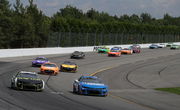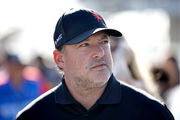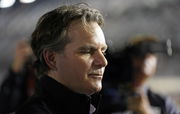
via Getty
DAYTONA BEACH, FLORIDA – AUGUST 23: Joey Logano, driver of the #22 Shell Pennzoil Ford, looks on during qualifying for the NASCAR Cup Series Coke Zero Sugar 400 at Daytona International Speedway on August 23, 2024 in Daytona Beach, Florida. (Photo by James Gilbert/Getty Images)

via Getty
DAYTONA BEACH, FLORIDA – AUGUST 23: Joey Logano, driver of the #22 Shell Pennzoil Ford, looks on during qualifying for the NASCAR Cup Series Coke Zero Sugar 400 at Daytona International Speedway on August 23, 2024 in Daytona Beach, Florida. (Photo by James Gilbert/Getty Images)
For quite some time now, veteran NASCAR drivers have been questioning the sport’s authoritarian practices. This is because of the unequal imposition of penalties and strict actions. Remember what Kevin Harvick said a few days ago? “We’ve got to make some accountability and some decisions right off the bat to enforce that accountability right on the spot,” he said. And rightly so. If authorities let players off the hook easily, they feel it is okay for them to wreck opponents, and they lose respect for the sport itself. But, recently, a Martinsville phenom pointed out to another apparent reason for the increased wrecks. And it seems to make complete sense.
In the hallowed progression of NASCAR talent, Martinsville Speedway has long served as a proving ground where legends cut their teeth before ascending to Cup Series glory. When Joey Logano burst onto the scene in 2008 as a teenage prodigy with Joe Gibbs Racing, he did so with the backing of a proper development system—one where he was paid to drive from age 18. That traditional pathway has eroded dramatically, replaced by what Logano now identifies as the root cause behind the increasingly chaotic racing in NASCAR’s developmental series.
Logano’s recent comments cut straight to the heart of a transformation that has fundamentally altered driver behavior. Where once young drivers answered to veteran team owners who demanded accountability, today’s landscape reveals a troubling pay-to-play structure that Logano believes directly contributed to the controversial incidents at Martinsville.
ADVERTISEMENT
Article continues below this ad
Exposing the dynamic-altering change
“I got paid to drive a car since I’ve been 15 years old,” Logano explained. “I’ve had a boss that pays to drive, like I got paid to drive their car. So I had someone to answer to.” The contrast with today’s reality couldn’t be starker: “With the Xfinity series these days and the truck series, all of them are paying to drive the car. So you will not get fired if you’re bringing money to the table.”
💰 “You will not get fired if you’re bringing money to the table.”@joeylogano speaks on the current dynamic in the @NASCAR_Xfinity Series and how the structure of the Cup Series differs from the lower levels.
More #BehindTheWheel with the 3X champ → https://t.co/UiHLwgVHC5 pic.twitter.com/pdWtHm2LGx
— SiriusXM NASCAR Radio (Ch. 90) (@SiriusXMNASCAR) April 1, 2025
Logano’s most pointed criticism centers on the absence of veteran leadership in the garage. “Now you don’t have the elder statesmen there that have been there for a long time that are showing everyone how to do a certain thing and command their respect,” he emphasized. This missing layer of accountability from experienced team owners has created a void in driver development, allowing aggressive tactics to go unchecked.
The financial disparity is striking. At the Las Vegas weekend in 2025, the Cup Series boasted an $11,055,250 purse, while Xfinity competitors battled for just $1,651,939—a $149,339 drop from the previous year. Truck Series drivers faced an even more dismal $782,900 purse. This economic reality forces teams to accept drivers with funding regardless of behavior, as Logano noted: “It takes a lot for a race team to say, you can’t drive our car anymore. When you’re bringing millions of dollars to drive the car.”
Everyone witnesses these effects during track events each week. Veteran ownership that enforces protocol helps young racing competitors develop the required behavioral standards for Cup Series competition. “And then they’re learning this is how you race, and this is what they do,” Joey Logano continued, highlighting how these uncorrected behaviors become ingrained. King Richard Petty commented on the problem with younger stars in the sport, saying, “Nobody tells these kids at 12 or 13 – RESPECT! Respect your equipment, respect the other driver, and respect his ability. If you race him that way, he’s going to race you that way.” But Logano also points out to transition, and related developments in the driver.
The move from lower series racing to the Cup Series produces a significant adjustment. “The dynamic of everything’s different when you get to the cup level because now almost all the drivers in the cup series are getting paid,” Joey Logano pointed out. “So now you have a boss, right? Now, there’s a lot more on the line. Now, you can’t afford to get suspended. You can’t afford to lose points. You can’t afford to do all this stuff, but you don’t know how to do that now because you weren’t trained to do that.”
Trending
ADVERTISEMENT
Article continues below this ad
History Repeating – NASCAR’s Recurring Development Dilemmas
This isn’t NASCAR’s first developmental crisis. During the 2008 economic downturn, Brian France acknowledged similar challenges, stating, “NASCAR as an industry is not immune. We have to work very hard to be good partners and work through these challenging times.” Then, as now, manufacturer support declined amid broader financial pressures.
The popularity of Xfinity Series racing continues to grow unexpectedly despite initial hurdles. The level of interest in CW’s broadcasting has surged to 1.286 million viewers during 2025 while demonstrating a 30% rise compared to last year. Audiences for the Homestead race, at 1.16 million, demonstrated a 46% higher viewer count than Richmond received in the 2024 race. Flawless competition growth occurs simultaneously with uncut race styles produced through the pay-to-drive system.
Kyle Larson added perspective to the financial imbalance last season, noting, “I bet you the top four drivers in the World of Outlaws Sprint Car Series are making more money than a third to half of the Cup Series guys.” When sprint car racers potentially out-earn NASCAR’s premier series competitors, the economic pressures on developmental drivers only intensify, perpetuating the cycle Joey Logano identifies.
ADVERTISEMENT
Article continues below this ad
As NASCAR faces an uncertain future, with GEICO pulling sponsorship and Xfinity announcing it won’t return as title sponsor beyond 2025, Logano’s concerns highlight a critical crossroads: Can NASCAR rebuild a development ladder that produces disciplined racers, or will the financial realities continue to shape a different kind of competitor?
ADVERTISEMENT
ADVERTISEMENT
ADVERTISEMENT
ADVERTISEMENT






